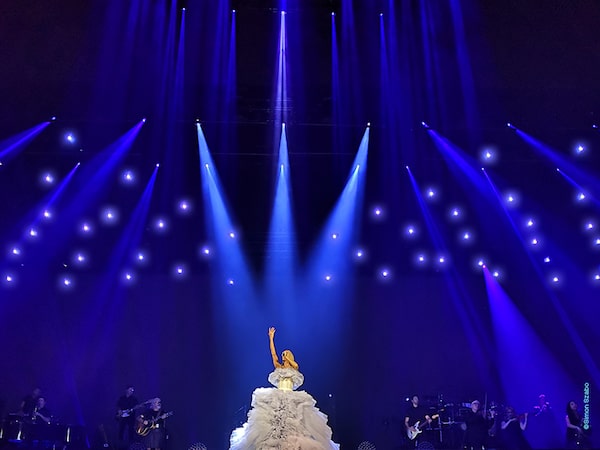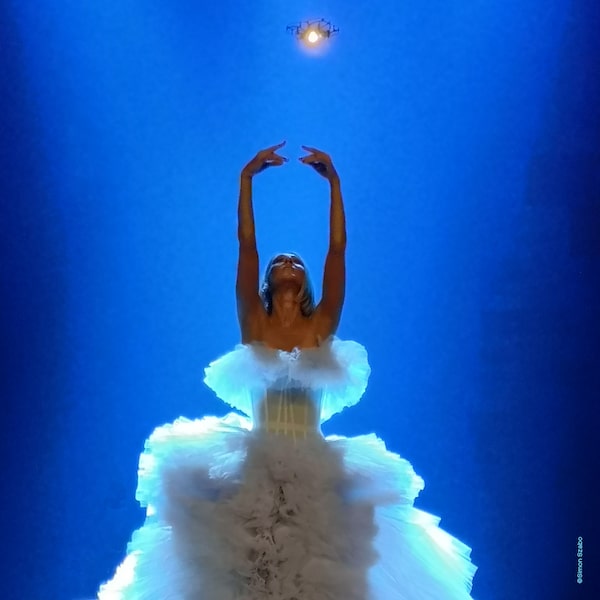
Over 100 micro drones rise from the stage as Celine Dion raises her arms during a performance of her epic ballad My Heart Will Go On.simon Szabo/Handout
There’s a buzz around Celine Dion these days, and we’re not talking her new album, Courage. For her current tour, during the epic ballad My Heart Will Go On, more than 100 microdrones rise from the stage like so many fireflies as the singer raises her arms. As the song reaches its crescendo, the hovering illumination devices turn blue and throng around Dion before descending back to the stage one by one. A remaining lit drone dips to the performer before flying off. The Disney-like moment is over – Dion’s white dress might be a loaner from Cinderella – but the singer’s heart, and the show, will go on.
The use of microdrones for indoor concerts is a recent innovation. Canadian fans may have been introduced to the dancing lights during Drake’s Aubrey & the Three Migos Tour, in which flying waves and a drone-swarm cloud were achieved during a pair of songs. Then again, the flying foam Ferrari (supported by a fleet of tiny drones controlled offstage) might have been more memorable than any floating lights.
For both the Drake tour and the Dion concerts, the drone technology was developed by Verity Studios AG, a Zurich-based pioneer in small autonomous copters. The effect is innovative, but is it worth the trouble and cost? Will we see more of it, or will this latest razzle-dazzle go the way of dry ice and drum solos?
For Raffaello D’Andrea, the sky is the limit for the developing technology. “We see autonomous indoor drones as a platform that enables the movement of any payload in 3D space,” says the Verity Studios chief executive and founder, who agreed to an e-mail interview with The Globe and Mail. “We’ve just released the Lucie mini beam, which is a miniature flying spotlight, and we’re playing with a variety of other effects."
The drone, equipped with powerful lights, can either follow preset choreography or fly autonomously. The sound the tiny device produces is “quieter than conversational speech,” according to D’Andrea.
Verity’s Lucie microdrone weighs 50 grams and is roughly the size of an adult hand. Speaking of which, Enrique Iglesias’s right paw was bloodied by a larger, non-Verity device during a performance in Tijuana in 2015. The singer grabbed a camera-equipped drone, slicing a finger in the process. "Something went wrong and he had an accident,” read a statement released by the singer after the concert.
Because of safety and insurance issues, some venues have instituted bans against drones. The consumer drone used in the outdoor Iglesias concert was significantly heavier than Verity’s specialty indoor devices, which are, according, to D’Andrea, considerably safer. “We haven’t had any challenges with getting approvals for our drones,” he says. “We’ve flown in more than 100 venues, many with no-drone policies, in almost 200,000 fully autonomous flights over people.”

Front-of-house technician and show designer David Diamond says that drones are here to stay.simon Szabo/Handout
In addition to the shows with Drake and Dion, Verity’s drones have been used by Cirque du Soleil, Metallica and Chinese film director Zhang Yimou, who employed the devices to portray a wave of flying trash for his conceptual stage show 2047 Apologue. It remains to be seen if drone lighting will become a standard effect on theatrical stages, or if the innovation will be reserved for extravaganzas.
“Unless the choreographer wanted to see drones in the piece for some reason, I could never imagine the use for them,” says American lighting designer David Finn, whose résumé includes work with the Canadian Opera Company and the National Ballet of Canada. "I would say that the use of drones is only interesting for rock 'n' roll or spectacle.”
Verity’s D’Andrea would not disclose his prices publicly, but did allow that his flying machines aren’t cheap. “Suffice it to say this is a high-end effect." It has been reported that for its 2016 Broadway show Paramour, Cirque du Soleil spent $500,000 for its flying lampshades.
For big-ticket concert stages, one prominent designer sees the use of mini-drones as, literally, on the rise. “It could be one drone lifting off a performer’s hand, to give the illusion of a star, or it could thousands of them, filling the area as a night sky,” says David Diamond, a front-of-house technician and show designer who worked on the Drake tour. “It adds a 3D dynamic that helps space, and I think, as prices come down, we’ll see more of them."
Diamond says while Verity’s drone system on the Drake tour wasn’t perfect – “a few hiccups here and there” – the experience of working with the new technology was a “fun challenge," and that drones are here to stay. “The only limits,” he believes, "are our creativity and our own minds.”
Live your best. We have a daily Life & Arts newsletter, providing you with our latest stories on health, travel, food and culture. Sign up today.
 Brad Wheeler
Brad Wheeler